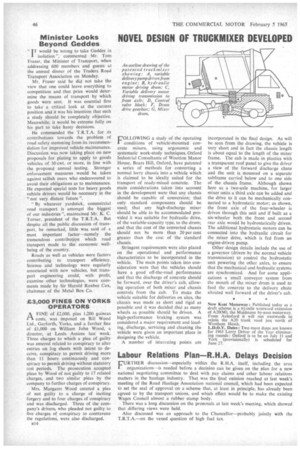NOVEL DESIGN OF TRUCKMIXER DEVELOPED
Page 48

If you've noticed an error in this article please click here to report it so we can fix it.
rOLLOWING a study of the operating
conditions of vehicle-mounted concrete mixers, using ergonomic and systematic work-study techniques, Oxford Industrial Consultants of Wootton Manor House, Boars Hill, Oxford, have patented a series of methods for converting a normal lorry chassis into a vehicle which is claimed to be ideally suited for the transport of ready-mixed concrete. The main considerations taken into account in the development were that any chassis should be capable of conversion; that only standard components should be used; that any high-discharge mixer should be able to be accommodated provided it was suitable for hydraulic drive, of the variable-capacity type, to the drum; and that the cost of the converted chassis should not be more than 20 per cent greater than the cost of the standard chassis.
Stringent requirements were also placed on the operational and performance characteristics to be incorporated in the vehicle. The main points taken into consideration were that the vehicles should have a good off-the-road performance and that the discharge of concrete should be forward, over the driver's cab, allowing operation of both mixer and chassis controls from the cab. To make the vehicle suitable for deliveries on sites, the chassis was made as short and rigid as possible and it was decided that as many wheels as possible should be driven. A high-performance braking system was considered a major requirement and loading, discharge, servicing and cleaning the vehicle were given an important place in designing the vehicle.
A number of interesting points are
incorporated in the final design. As will be seen from the drawing, the vehicle is very short and in fact the chassis length is about equal to the length of the mixer frame. The cab is made in plastics with a transparent roof panel to give the driver a view of the forward discharge chute and the unit is mounted on a separate subframe carried below and to one side of the chassis frame. Although shown here as a two-axle machine, for larger mixer units a third axle can be added and the drive to it can be mechanically connected to a hydrostatic motor; as shown, the front axle of the four-wheeler is driven through this unit and if built as a six-wheeler both the front and second rear axle would be hydrostatically driven. The additional hydrostatic motors can be connected into the hydraulic circuit for the mixer drive, which is fed from an engine-driven pump.
Other design details include the use of a governor (driven by the normal vehicle transmission) to control the hydrostatic unit powering the other axles, to ensure that the mechanical and hydraulic systems are synchronized. And for some applications a small conveyor system from the mouth of the mixer drum is used to feed the concrete to the delivery chute situated well forward of the driver's cab.


















































































































































































